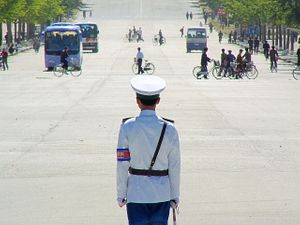Six months after their last meeting, delegates of the inter-Korean committee of the Kaesong Industrial Complex (KIC) finally reconvened on June 26. Although the committee failed to agree on any of the major issues, the political environment surrounding the meeting suggested that there may be opportunities for broader dialogue in the near future.
The joint committee met for the first time in August of last year and agreed at that time to hold quarterly meetings to coordinate “developmental normalization” of the KIC. These meetings were necessitated by North Korea’s unilateral withdrawal of workers from the complex in April of 2013. Faced with the prospect of permanent closure, the two Koreas eventually agreed to reopen the complex in August 2013 and to invite foreign investors to this precarious symbol of inter-Korean cooperation. The committee was established to oversee this process, while also resolving issues related to compensation for South Korean companies and enhancing the complex’s communications capacity.
Earlier this month, with Pyongyang remaining unresponsive to Seoul’s calls for a meeting, it seemed as though North Korea might be abrogating its side the agreement. The very fact that the representatives from the two Koreas met at all, albeit later than the expected date, showed that the North Korean government is interested in keeping the KIC going for the time being.
The South Korean side hoped to come to an agreement on issues regarding customs, freer access for South Koreans at the complex, and improved communication infrastructure. Meanwhile, North Korean representatives called for improved services and wages for workers at the KIC. In addition, they called for Seoul to end the economic sanctions it imposed in 2010.
Called the May 24 Measure, Seoul imposed the sanctions on Pyongyang after the North Korean government refused to take responsibility for the sinking of the South Korean corvette Cheonan in March 2010. The sanctions included five key components: halting all inter-Korean commerce, freezing all investments to North Korea, prohibiting South Koreans from travelling to North Korea (with the exception of KIC and Kumgang Mountain national park), suspending all non-humanitarian assistance, and closing South Korean waters to North Korean vessels.
As discussed in a previous article, South Korea is in no position to repeal the sanctions entirely so long as North Korea continues to escalate tensions along the contested maritime border. As a result, major breakthroughs at this joint committee meeting were not possible.
Nonetheless, Seoul has cautiously raised the possibility of slowly reducing the intensity of the sanctions to facilitate cooperation. In fact, South Korean Minister of Unification Ryoo Kihl-jae recently hinted at the possibility that Seoul will eventually repeal the sanctions without necessarily revisiting the scuttling of the Cheonan. Specifically, Ryoo said that as the two governments establish mutual trust, opportunities to end the May 24 Measure may arise.
Seoul has already slightly eased some of the restrictions from its 2010 sanctions and allowed an NGO called Nation’s Forest to help the North Korean government combat tree pests in Pyongyang, Kangwon Province, and North Pyongan Province. The underlying hope is that these small avenues of cooperation will eventually establish the grounds for greater dialogue.
Of course, the ongoing maritime tensions in the Yellow Sea are difficult to ignore. As if on cue, the North Korean army launched a furious diatribe on June 26 about provocative behavior by Seoul along the Northern Limitation Line, accusing the South Korean army of firing shots at North Korea. South Korea’s North-West Islands Defense Command told the press that it had engaged in training exercises and did fire shots but in a southwesterly direction, away from the disputed maritime border.
Regardless of this, North Korea responded by firing three short-range missiles. However, it is worthwhile noting that Pyongyang chose to display its retaliation on the other side of the peninsula near Wonsan, firing in a northeasterly direction. This may be a signal that the North Korean government does not wish to further escalate tensions at this moment.
Although the recent meeting proved fruitless, conditions for future KIC meetings and small areas of inter-Korean cooperation appear to have been established. With the joint committee expected to meet again sometime in August, perhaps some changes might come to KIC sooner than expected.
































